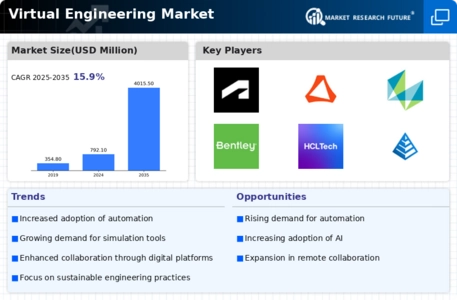Top Industry Leaders in the Virtual Engineering Market
Competitive Landscape of the Virtual Engineering Market
The virtual engineering market, encompassing design, development, and testing within a digital environment, is experiencing rapid growth fueled by advancements in 3D modeling, simulation tools, and augmented/virtual reality. This dynamic landscape boasts a diverse set of players with varying strategies and approaches. Examining these key competitors, their tactics, and the factors influencing market share is crucial for understanding the current state and future direction of this exciting domain.
Key Players:
- Siemens PLM Software
- Dassault Systems
- Ansys
- Autodesk, Inc
- Altair Engineering, Inc
- Hexagon AB (MSC Software)
- Bentley Systems
- HCL Technologies
- Carlson Software
- PTC
- IBM Corporation
- Accenture
- Bosch Rexroth
- Capgemini
Factors Influencing Market Share:
- Product Portfolio and Innovation: Comprehensive suite of solutions catering to diverse engineering needs, including design, simulation, collaboration, and data management, plays a crucial role. Continuous investment in research and development to stay ahead of the curve is essential.
- Customer Focus and Industry Expertise: Understanding specific industry challenges and tailoring solutions accordingly is key to building trust and long-term relationships with clients. Deep domain knowledge and strong support services add value.
- Pricing and Business Model: Flexible pricing options, including subscription models and pay-per-use structures, cater to diverse budget constraints and project requirements. Striking a balance between affordability and profitability is crucial.
- Ease of Use and Integration: Intuitive user interfaces, seamless integration with existing software and hardware ecosystems, and smooth cloud collaboration tools enhance user adoption and drive market share.
- Partnerships and Ecosystem Development: Collaborations with technology providers, hardware manufacturers, and educational institutions expand reach, foster innovation, and create a robust ecosystem around virtual engineering solutions.
New and Emerging Companies:
- AI-powered Design Optimization: Companies like nTopology and Autodesk are integrating AI and machine learning algorithms to automate design decisions, optimize performance, and generate innovative solutions.
- Digital Twins and Real-time Monitoring: Platforms like Bentley Systems and Siemens Xcelerator are creating digital twins, virtual replicas of physical assets, for real-time monitoring, predictive maintenance, and improved operation efficiency.
- Blockchain-based Data Security and Collaboration: Emerging companies are exploring blockchain technology to secure sensitive engineering data and facilitate tamper-proof collaboration on virtual projects.
Current Investment Trends:
- Cloud Migration: SaaS models and cloud-based platforms are receiving significant investment due to their accessibility, scalability, and global reach.
- VR/AR Integration: Investment in VR/AR technologies for immersive design reviews, training simulations, and remote collaboration is on the rise due to their potential to enhance communication and efficiency.
- Interoperability and Open Standards: There is a growing need for open standards and interoperable platforms to facilitate seamless data exchange and collaboration across different software and hardware systems.
- Industry-Specific Solutions: Tailoring virtual engineering solutions to specific industry needs, such as healthcare, aerospace, and automotive, is attracting investor interest due to the potential for significant growth opportunities.
Latest Company Updates:
Jan 20: Industry rivals Autodesk and PTC announce a strategic partnership to develop cloud-based collaboration tools for virtual engineering projects. This collaboration aims to break down siloes and improve data interoperability across different software platforms.
Jan 22: Cloud-based CAD software provider Onshape launches a free tier with limited features for students and startups. This move aims to democratize access to virtual engineering tools and foster the next generation of engineers.
Jan 10: The European Commission releases a proposal for open standards in virtual engineering software to combat vendor lock-in and promote data interoperability. This move could reshape the competitive landscape of the market.
Jan 7: Aerospace giant Boeing unveils its ambition to develop future aircraft entirely within a digital environment, from design to production. This shift towards virtual engineering promises faster development cycles and improved aircraft performance.
Jan 5: A UK-based company successfully uses VR technology to remotely guide technicians in repairing offshore wind turbines. This application showcases the potential of VR for remote maintenance and field operations in extreme environments.









